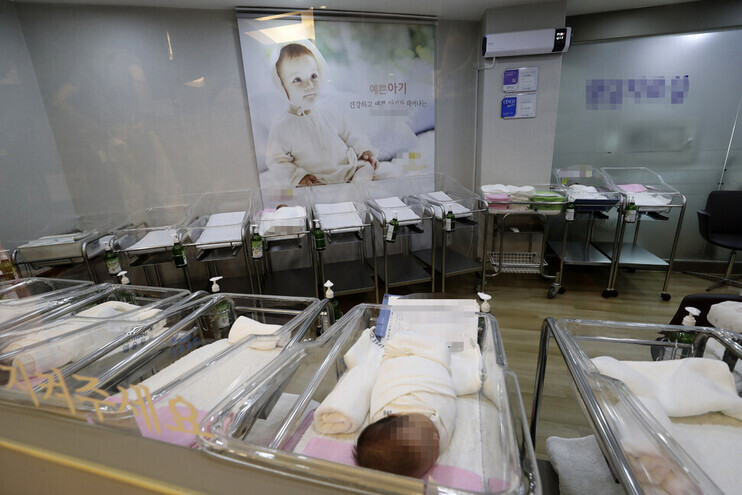hankyoreh
Links to other country sites 다른 나라 사이트 링크
Korea’s closing demographic window will shave 1.13 points off economic growth annually over coming decades

An analysis has shown that South Korea’s demographic structure has entered a phase in which it will lower the country’s per capita gross domestic product (GDP) growth rate by an average of 1.13 percentage points per year over the next 30 years.
In a policy recommendation for raising the country’s birth rate released on Thursday, the Korea Chamber of Commerce and Industry’s Sustainable Growth Initiative analyzed that Korea’s demographics shifted from a demographic bonus, where economic growth was boosted by a high birth rate, to a “demographic onus,” where economic growth is constrained by a low birth rate and aging population, around 2016.
That is, South Korea has already entered a period of declining economic growth as the working-age population shrinks and the dependent population grows.
According to the report, the percentage of Korea’s overall population that fell into the “working age” demographic (15-64 years old) increased from 54.4% in 1970 to 71.7% in 2020, raising the per capita GDP growth rate by an average of 0.93 percentage points per year.
However, by 2050, this figure is expected to fall to 51.2%, lowering the per capita gross domestic product growth rate by an average of 1.13 percentage points per year from 2020 to 2050.
Korea has allocated 52 trillion won per year (US$40 billion, as of 2022) to respond to the declining birth rate, which amounts to 210 million won per birth. Yet despite these efforts, the total fertility rate is 0.78, far below the replacement fertility rate of 2.1, which is the rate needed to maintain the current population.
“Korea has fallen into a low birth rate trap in which the number of women of childbearing age, the total number of births, and the number of children desired by married couples have all decreased while young adults’ expected income has not kept pace with consumption levels, causing the birth rate to fail to rebound and continue to decline,” the report said.
The report cites a number of factors that have contributed to the plunge in South Korea’s birth rate, which include the concentration of population in the greater Seoul area and high housing costs, high investment in children and high levels of competition, labor market rigidity, men’s low participation in household work, and changing attitudes among younger Koreans.
The report notes that rising incomes and increased economic activity by women are not necessarily at odds with birth rates. In the past, higher women’s labor force participation rates were associated with lower birth rates due to opportunity costs, but since 2000, high-income countries have seen a parallel rise in women’s labor force participation and birth rates.
The report lists affordable and flexible child care, the cooperative role of fathers in child care, pro-family social norms, and flexible labor markets as characteristics of countries where women’s social participation and birth rates are simultaneously high.
By Kim Hoe-seung, senior staff writer
Please direct questions or comments to [english@hani.co.kr]

Editorial・opinion
![[Column] Welcome to the president’s pity party [Column] Welcome to the president’s pity party](https://flexible.img.hani.co.kr/flexible/normal/500/300/imgdb/original/2024/0515/3917157400447943.jpg) [Column] Welcome to the president’s pity party
[Column] Welcome to the president’s pity party![[Editorial] Korea must respond firmly to Japan’s attempt to usurp Line [Editorial] Korea must respond firmly to Japan’s attempt to usurp Line](https://flexible.img.hani.co.kr/flexible/normal/500/300/imgdb/original/2024/0514/2317156736305813.jpg) [Editorial] Korea must respond firmly to Japan’s attempt to usurp Line
[Editorial] Korea must respond firmly to Japan’s attempt to usurp Line- [Editorial] Transfers of prosecutors investigating Korea’s first lady send chilling message
- [Column] Will Seoul’s ties with Moscow really recover on their own?
- [Column] Samsung’s ‘lost decade’ and Lee Jae-yong’s mismatched chopsticks
- [Correspondent’s column] The real reason the US is worried about Chinese ‘overcapacity’
- [Editorial] Yoon’s gesture at communication only highlights his reluctance to change
- [Editorial] Perilous stakes of Trump’s rhetoric around US troop pullout from Korea
- [Guest essay] Preventing Korean Peninsula from becoming front line of new cold war
- [Column] The state is back — but is it in business?
Most viewed articles
- 1[Column] Welcome to the president’s pity party
- 2Could Korea’s Naver lose control of Line to Japan?
- 3US has always pulled troops from Korea unilaterally — is Yoon prepared for it to happen again?
- 4[Editorial] Transfers of prosecutors investigating Korea’s first lady send chilling message
- 5[Column] Will Seoul’s ties with Moscow really recover on their own?
- 6Major personnel shuffle reassigns prosecutors leading investigations into Korea’s first lady
- 7Naver’s union calls for action from government over possible Japanese buyout of Line
- 8[Correspondent’s column] The real reason the US is worried about Chinese ‘overcapacity’
- 9[Editorial] Korea must respond firmly to Japan’s attempt to usurp Line
- 10Number of foreign residents in S. Korea triples over ten years